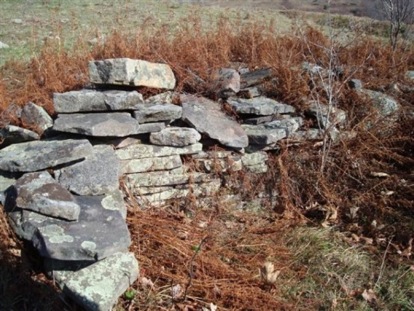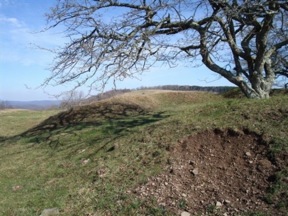A historian’s stroll across Camp Allegheny
Camp Allegheny rests inside the Monongahela National Forest (MNF) amidst the Potomac Highlands of Pocahontas County, West Virginia. Most visitors to the area are not aware of this resource, one of the best preserved Civil War battlefields. It is situated along the historic Staunton-Parkersburg Turnpike (Rt. 250) on Allegheny Mountain. Recently members of the State Historic Preservation Office had a rare opportunity to tour the landscape with Hunter Lesser, one of West Virginia’s experts on Civil War history.
Author of Rebels At The Gate: Lee and McClellan on the Front Line of a Nation Divided, Lesser walked the ridgetop with us, pointing out the area of combat and the Confederate winter quarters of 1861-1862. The Union soldiers, under the command of General Robert Milroy, also wintered in the same area on Cheat Mountain, about twenty miles to the northwest.
The Battle of Camp Allegheny, also known as Top of Allegheny, Allegheny Mountain Summit, or Camp Baldwin, occurred on December 13, 1861. Union forces moved from their winter quarters at Cheat Mountain Summit and planned a two prong attack on the Confederates at Allegheny. Approximately 1,900 Federal troops attacked 1,200 Confederate soldiers. Several charges and counter-charges were made throughout the day. In all, the fighting took seven and a quarter hours with no decisive outcome. The losses were about even, with Union at 147 to the Confederate’s 146.
 After the battle Confederate and Union troops stayed in their respective winter quarters. In the spring, both armies left the area and the vital road, the Staunton-Parkersburg Turnpike was unguarded. Later in the war, Confederate General “Stonewall” Jackson took advantage of this, using the turnpike during his famous Valley Campaign. Confederate General Edward Johnson would also earn both his full rank and nickname, “Allegheny” during the fight and harsh winter on Allegheny Mountain.
After the battle Confederate and Union troops stayed in their respective winter quarters. In the spring, both armies left the area and the vital road, the Staunton-Parkersburg Turnpike was unguarded. Later in the war, Confederate General “Stonewall” Jackson took advantage of this, using the turnpike during his famous Valley Campaign. Confederate General Edward Johnson would also earn both his full rank and nickname, “Allegheny” during the fight and harsh winter on Allegheny Mountain.
Lesser narrated the battle as well as shared stories recorded by the encamped soldiers, such as the letters written to and from a seventeen year old Union soldier, Josie Gordon. Upon joining the army, his father, who was also a soldier, wrote, “Write to me often, obey your officers, and die sooner than be a calf or a coward.”[1]
Josie was indeed killed during the fight. His last letter, addressed to Major Jonathan Gordon, illustrates his sense of duty: “You surely should not be surprised that I should, in this hour of extreme peril to my country, offer her my feeble aid.”[2]
In 1903 Ambrose Bierce published A Bivouac of the Dead about the area and the battle’s events. Bierce wrote, “Crowning some low hills within a stone’s throw of the house are long lines of old Confederate fortifications, skillfully designed and so well ‘preserved’ that an hour’s work by a brigade would put them into serviceable shape for the next civil war.”[3]
The significance of this landscape is enriched by the retelling of these accounts. It is also humbling to view this landscape. In 1990, Camp Allegheny was listed in the National Register of Historic Places as nationally significant for its association with the American Civil War, landscape architecture, and its potential for additional information through archaeological investigation.
[1] Hunter Lesser. Rebels At The Gate: Lee and McClellan on the Front Line of a Nation Divided (Naperville, Il: Sourcebooks, Inc), 252.
[2] Ibid, 259.
[3] Ambrose Bierce, “A Bivouac of the Dead”, http://www.ambrosebierce.org/bivouac.htm
————
Bethany Canfield is currently employed as a National Register and Architectural Survey historian for the West Virginia State Historic Preservation Office. Her passion for the American Civil War passed from her grandfather during a fourth-grade research project. Later, she interned at Fredericksburg & Spotsylvania National Military Park (FSNMP) and Gettysburg National Military Park, where she presented various walking tours. Graduating from Mercyhurst College in Erie, PA with a B.A. in History, concentrated in Pubic History, Canfield was among the first class of Public Historians. While at Mercyhurst, she also studied at Gettysburg College for the Civil War intensive Gettysburg Semester program. Bethany then continued her education at Shippensburg University where she graduated with a M.A. in Applied History. During graduate school, Bethany returned to Fredericksburg as a seasonal park ranger/historian.
